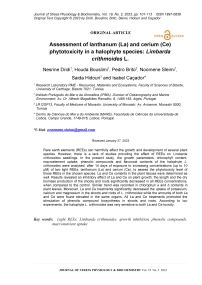Assessment of lanthanum (La) and cerium (Ce) phytotoxicity in a halophyte species: Limbarda crithmoides L
Автор: Dridi Nesrine, Bouslimi Houda, Brito Pedro, Sleimi Noomene, Hidouri Saida, Caador Isabel
Журнал: Журнал стресс-физиологии и биохимии @jspb
Статья в выпуске: 2 т.19, 2023 года.
Бесплатный доступ
Rare earth elements (REEs) can harmfully affect the growth and development of several plant species. However, there is a lack of studies providing the effect of REEs on Limbarda crithmoides seedlings. In the present study, the growth parameters, chlorophyll content, macroelement uptake, phenolic compounds and flavonoid contents of the halophyte L. crithmoides were analysed, after 14 days of exposure to increasing concentrations (up to 10 µM) of two light REEs; lanthanum (La) and cerium (Ce), to assess the phytotoxicity level of these REEs in the chosen species. La and Ce contents in the plant tissues were determined as well. Results revealed an inhibitory effect of La and Ce on plant growth; the length and the dry biomass production of the shoots and roots significantly decreased in all REEs concentrations, when compared to the control. Similar trend was recorded in chlorophyll a and b contents in plant leaves. Moreover, La and Ce treatments significantly decreased the uptake of potassium, calcium and magnesium in the shoots and roots of L. crithmoides while the amounts of both La and Ce were found elevated in the same organs. All La and Ce treatments promoted the stimulation of phenolic compound biosynthesis in shoots and roots. According to our experiments, the halophyte L. crithmoides was very sensitive to both La and Ce toxicity.
Light rees, limbarda crithmoides, growth inhibition, phenolic compounds, macronutrient uptake
Короткий адрес: https://sciup.org/143180099
IDR: 143180099
Текст научной статьи Assessment of lanthanum (La) and cerium (Ce) phytotoxicity in a halophyte species: Limbarda crithmoides L
Rare earth elements (REEs) present a group of 17 metallic elements consisting of 15 lanthanides and Scandium and Yttrium. This group is divided into heavy and light rare earth elements according to their atomic weights (Henderson 1984). Rare earth elements are widely used in several modern technologies which increase their demand and thus their exploitation from mineral deposits resulting in huge areas of REEs mine tailings (Alonso et al. , 2012). In addition, REEs are known to be present, with high concentrations, in the phosphate ores used as the raw material of agriculture fertilizers and in the phosphogypsum wastes as well (El-Zrelli et al. , 2021).
The increased application of fertilizers and the mismanagement of the mineral deposit wastes (mine tailings and phosphogypsum) can lead to the accumulation of REEs in various environmental components (soil, water, agriculture lands, plants, animals, etc.) (El-Zrelli et al. 2021; Liu et al. 2022). For example, the contamination of Gabes Golf in Tunisia due to the uncontrolled discharge of phosphogypsum from the phosphate fertilizer factories resulted in the contamination of seafood products (El-Zrelli et al. , 2019a,c). Moreover, the beach sand, that become highly enriched with REEs contained in the phosphogypsum, is used by local farmers as a fertilizer for crop fields (El-Zrelli et al. , 2021). Therefore, the consumption of the REEs contaminated seafood and edible plants potentially threats human health.
In these circumstances, the control of REEs contaminated areas has become a serious environmental concern (Li et al. , 2012; Liu et al. , 2022). The monitoring of the behaviour of plants grown on REEs contaminated soils could help to investigate the physiological response of the plant to the adverse conditions and therefore to be used as stress bioindicator species for soil quality (Parmar et al. , 2016).
The toxicity of the two most abundant REEs, lanthanum (La) and cerium (Ce), was described in various plants species (Kotelnikova et al., 2019 and references therein). The presence of La and Ce in the growth medium can increase the generation of reactive oxygen species (ROS) leading to an oxidative stress in plant cells. It has been well reported that the overaccumulation of these free radicals may influence cell division and development (Reichheld et al., 1999; Ros-Barcelo et al., 2002) and induce irreversible damage such as the inhibition of photosynthesis, lipid peroxidation of cell membranes and even cell death (Jones, 2000; Imlay 2003). Kotelnikova et al. (2019) reported a significant decrease in root length and mitotic index in Allium cepa plants grown in the presence of La and Ce. Moreover, a concentration of 10 µM Ce decreased the photosynthetic yields in Chlamydomonas reinhardtii (Kosak née Röhder et al., 2018).
Limbarda crithmoides is natively distributed along the salt marshes and wetlands of the Mediterranean Sea (El-Sherbeny et al. , 2021). This plant species is abundantly distributed in Tunisia; it can be found in Galite islands, Tabarka, Carthage, Bizerte, Korba, Sfax, Gabes, Gafsa, Kebili and El-Djerid. This halophyte, with high salt-tolerant features, antioxidant and biological activity (Zurayk et al. , 1996; Andreani et al. , 2013), is among the common medicinal plant species in the Mediterranean coast. It can be also consumed by grazing animals (El-Sherbeny et al. , 2021).
Despite that the REEs toxicity has been previously assessed in several plant species; there are no available reports on the effect of La and Ce on Limbarda crithmoides. The objectives of this study were to investigate the response of Limbarda crithmoides to the presence of increasing La and Ce concentrations in the hydroponic solution through the evaluation of the growth pattern, photosynthetic pigment levels, La and Ce uptake, nutrient balance, and secondary metabolite accumulation.
MATERIALS AND METHODS
Plant material and growth conditions
Seeds of Limbarda crithmoides were collected from mature plants grown in the north shore of the lagoon of Bizerte (Menzel Jemil, Bizerte, Tunisia; 37°14'19"N, 9°54'59"E). The species was identified by Fray Fournier and presented in the Herbarium specimens of Limoges University (LIMO) (Catalogue Number: LIMO02205).
Seeds were selected and soaked in distilled water for 2 h then transferred to plastic pots consisting of perlite and gravel mixture (2:1 v/v), used as a substrate, and placed in in a semi-controlled greenhouse with natural photoperiod, mean temperature of 25 ± 5°C and relative humidity between 60% – 90%. The substrate was regularly irrigated with tap water until the germination of seeds, and then the obtained seedlings were irrigated with ¼ Hoagland nutrient solution (Hoagland, 1950).
REEs exposure conditions
After 50 days of sowing, L. crithmoides seedlings were transferred into hydroponic system in a controlled chamber (Fitoclima S600, Aralab, Rio de Mouro, Portugal; with a photoperiod of 12/12 h day/night, a mean temperature of 25±5 °C, and a relative humidity of 60–80%) where 9 groups of 32 uniform seedlings were separately placed in dark-walled polypropylene tubes (two seedlings / tube) containing 50 mL of fresh nutritive solution for five days to acclimatize. Afterward, five REEs concentrations were tested; 0, 1, 2.5, 5 and 10 µM of La or Ce (prepared from lanthanum and cerium certified reference standard solutions, 1000 mg/L of La or Ce, high purity, HNO3 2% (v/v), Sigma Aldrich, St Louis, CA, USA). Grown seedlings (aged of 50 days) were treated with the prepared REEs solutions for 14 days. The nutrient solutions supplemented with La or with Ce were renewed every two days.
Plant harvesting
At the end of treatment experiments, plants of each group were harvested and separated into shoots and roots, and the length of each plant organ was measured. Subsequently, roots of treated plants were washed by CaCl2 (5%) to remove adsorbed REEs then the two organs were rinsed with distilled water (Stolt, 2003). All shoots and roots samples were immediately weighed to determine the fresh biomass of the plant tissues before drying process. After 7 days of oven drying at 70±2 °C, dry weight contents of the samples were determined and then plant tissues were ground to fine powder.
Concerning the analysis of the photosynthetic pigments, the collection of the fresh leaves was carried out on a second cluster of plants treated under the same conditions as the first cluster collected and used to obtain the dry matter.
Due to the limited plant biomass obtained at the end of the exposure experiments, four L. crithmoides seedlings were assembled together as one sample and each REE concentration was consisting of 8 replicates.
Chlorophyll determination
Photosynthetic pigments (chlorophyll a and b ) were extracted from plant leaf tissues by ethanol 80% (v/v) as described in Bankaji et al. (2016).
Elemental determination
Briefly, macronutrients (K, Ca, and Mg) and REEs (La and Ce) were extracted after a heated attack at 110 °C for 2 h of the dry samples (shoots and roots in powder) using a mixture of three acids (nitric–sulfuric– perchloric; 10:1:0.5; v/v/v) (Sleimi et al. , 2022, Dridi et al. , 2022c,b). Macronutrient contents were determined by atomic absorption spectrometry (Perkin Elmer PinAAcle900T, altham, MA, USA) (Dridi et al. 2022c,b), and those of REEs were determined by inductively coupled plasma mass spectrometry (ICP-MS; Perkin-Elmer NexION2000C) (Brito et al. , 2020).
Phenolic compound and flavonoid determination
Phenolic compounds and flavonoids were quantified following Velioglu et al. (1998) and Lamaison and Carnat (1990) procedures, respectively, after the extraction of these substances by methanol 80% (v/v) from dried plant samples (Dridi et al. 2022b,c).
Statistical analysis
Each analysis was performed in eight biological replicates (four plant/ replicate, n = 8). STATISTICA 8.0 software was used for the statistical analysis of data. All results were presented as means ± standard deviation (SD). The statistical differences among the treatments were treated by one way ANOVA analysis and Tukey honest significant difference (HSD) test and the difference between results is considered significant at p < 0.05. The relations between all analysed parameters were tested by principal component analysis (PCA).
RESULTS AND DISCUSSION
Assessment of plant growth
At the end of La and Ce exposure experiments, results in Figures 1 and 2 showed an obvious inhibition effect on plant growth response in increasing REE concentration in the hydroponic solution. The analysis of the morphological aspect (Figure 1) of the treated plants showed that all La and Ce concentrations slowed the growth of L. crithmoides by reducing plant height and giving wilted leaves in the highest REEs concentrations (10 µM La; Figure 1A and 5-10 µM Ce; Figure 1B).
Indeed, when compared to the control, the measured lengths and the dry biomass production of the shoots and roots of Limbarda crithmoides were significantly reduced in all La and Ce applied doses ( p < 0.05; Figure 2).
Depending on the level of plasticity that plants possess to deal with adverse environmental conditions, for example in response to abiotic stress as metallic stress, morphological and physiological changes might occur. These changes can affect plant growth and productivity, metabolic balance, and nutritional potential (Altman, 2003; Macedo, 2012). In the present study, our results revealed that varying La and Ce concentrations impaired the growth of Limbarda crithmoides in decreasing the length and the dry biomass production of the shoots and roots of the treated plants with the increase of REE dose in the growth medium (Figures 1 and 2). These findings were in line with several previous studies: Zeng et al. (2006) and Liu et al. (2018) reported a significant reduction in shoot and root biomass in rice and maize plants treated with increased La doses. A significant decrease was also noticed in citrus rootstock biomass under the effect of elevated La concentrations (Yin et al. 2021). A significant decrease in plant biomass was also noticed in Raphanus sativus grown in presence of Ce (Zhang et al. 2015).
The observed deleterious effect on the growth of Limbarda crithmoides could be explained by the fact that abiotic stressors such as REEs might affect several growth regulators as cytokinin, gibberellin, and auxin. It has been reported that metal stress alters the expression of auxin efflux carrier genes resulting in changes in auxin metabolism and inducing modification in auxin distribution throughout the plant organism (Schrader et al. , 2003; Leyser, 2005; Paponov et al. , 2005). Moreover, changes in both auxin conjugation and auxin sensitivity, due to the stress, can alter the activity of indole acetic acid and therefore affect plant morphogenesis (Jiang et al. , 2007).
Additionally, it has been well documented that metal toxicity affects plants photosynthetic machinery through the disruption of the structure and function of photosynthetic enzymes, where these harmful effects are generally related to the suppression of photosynthetic proteins, alteration of protein metabolism and replacement of essential cations from specific binding sites inducing nutrient imbalance (Aggarwal et al. , 2012; DalCorso et al. , 2013). Results in Table 1 revealed the inhibition of photosynthetic pigments synthesis under REEs stress; a significant decrease in Chl a and b contents in leaves of all La and Ce treated plants was noted when compared to the control ( p < 0.05). These might be explained by an increase in chlorophyllase activity under the effect of REEs or a disturbance in chlorophyll biosynthesis (Mali and Aery, 2009). Indeed, metals can induce stomata closure leading to a reduced assimilation of intercellular CO2, that consequentially provokes a deactivation of several enzymes as Rubisco (the key enzyme of the Calvin cycle), sucrosephosphate synthase and nitrate reductase, and also a decrease in δ-aminolevulinic acid déshydratase (ALAD) and ferredoxin NADP+ reductase activities (Chaves et al. , 2009; Gupta et al. , 2009; Mumm et al. , 2011). Various previous studies were in accordance with our findings and reported the negative effects of REEs on chlorophyll contents. For example, La and Ce exposure reduced chlorophyll content in Hydrilla verticillata ( ang et al. , 2007). Chlorophyll levels were found also decreased in citrus rootstock and Lonicera japonica leaves treated with La (Yin et al. , 2021; Tian et al. , 2016).
REEs and Macro-nutrients uptake
According to the obtained results (Figure 3), La and Ce contents significantly increased in shoots and roots of L. crithmoides with the increase of the specific REE concentration in the hydroponic solution (p < 0.05). Despite that the accumulated amounts of La and Ce in roots of the treated plants were higher than those accumulated in the shoots, elevated quantities were also detected in shoots (up to 420 and 681 µg.g-1 D in the highest La and Ce concentration, respectively). This suggests that Limbarda crithmoides treated plants were unable to retain both La and Ce in their roots, which increased the translocation of these elements from roots into the aerial parts. Similar accumulation pattern was found in Helianthus annuus and Brassica chinensis treated with lanthanum and neodymium (Rezaee, 2017).
Mineral elements such as calcium, magnesium, potassium, iron, copper, etc. are known to be essential nutrients for plant metabolism. A deficiency in these elements can engender adverse effects on plant growth and development ( ang et al. , 2014). The addition of increasing La or Ce concentrations to the growth solution generally decreased macronutrients (K, Ca, Mg) uptake in the shoots and roots of L. crithmoides when compared to the control (Table 2). Potassium contents showed a significant decrease in shoots and roots of L. crithmoides in all La concentrations ( p < 0.05; Table 2) while the decrease was significant only in shoots and roots under 2.5–10 µM Ce ( p < 0.05; Table 2). The absorption of Ca significantly declined in shoots of all La and Ce treated plants and in roots of 5–10 µM La and Ce treatments (Table 2; p < 0.05). Magnesium levels were also significantly reduced in the shoots of all La and Ce treated plants (1–10 µM) and roots under 1–10 µM La doses (Table 2; p < 0.05). In roots, a nonsignificant decrease was observed in Mg content in La treatment; however, Mg was only significantly decreased in of the highest Ce concentrations (5–10 µM; Table 2; p < 0.05).
It has been reported that metals (including REEs) have been shown to compete for essential nutrient (K, Ca, Mg, Zn, etc.) binding sites due to their similar valence. This property enables these elements to replace essential metals in several metalloproteins and metalloenzymes that lead to produce mineral nutrient imbalance, cell membrane permeability, biomolecule structure alteration, and ultimately functional disorders (Burda et al. , 1995; Qiu et al. 2005; Zeng et al. , 2006).
Liu et al. (2022) mentioned that the application of combined REEs stress induced an increase in K, Ca and Mg levels in the leaves, stem and roots of Boehmeria nivea plants. Moreover, the Cd uptake decreased K, Ca and Mg content in Prunus dulcis shoots and roots (Nada et al. , 2007).
It has been demonstrated that both La and Ce can block K+– and Ca2+ –ionic channels in the endoplasmic reticulum and disrupt ionic channels implied in the xylem exudation in the symplast of plant roots (Schwenke and agner, 1992; Klusener et al. , 1995; Han et al. , 2005; Hu et al. , 2006; Yuan et al. , 2017). Moreover, Burda et al. (1995) stated that REEs (such as La and Ce) can compete for calcium binding sites within photosystem II. Tammeba et al. (2004) also reported that Ca uptake was completely inhibited by La acting as voltage dependent Ca channel antagonist. Vicia Faba species showed also a decrease in Ca content in roots of plants treated with La at a concentration of 1 mg.L-1 ( any et al. , 2012).
In addition, the decrease in Mg content in Limbarda crithmoides might be due to substitution of this element by La and Ce in the chlorophyll molecule; these changes can impair chlorophyll function and thus the entire photosynthetic process because of the unstable excitation state of the metal-substituted chlorophyll that induce a complete breakdown of the electron transport chain (Küpper et al. , 1996, 1998; Souri et al. , 2020).
Secondary metabolism response
The rise in ROS production is related to a wide range of abiotic stresses including metal stress (Patakas, 2012). Consequentially, plants deploy efficient scavenging pathways either through antioxidative enzymes and/or antioxidant secondary metabolites to reduce the harmful impacts of ROS or to maintain the ROS generation under control (Sharma and Dubey, 2005). Results in Table 2 showed that phenolic compounds, in the shoots and roots of plants treated with different La and Ce concentrations, were more than 2-fold higher than that of the control ( p < 0.05). Our findings showed that all treated plants had a similar behaviour in terms of biosynthesis of phenolic compounds in the shoots and roots in response to varying doses of La and Ce. In contrast, a significant increase was only recorded in flavonoid contents in shoots of all La and Ce treated plants ( p < 0.05) and no significant variation was noted in the roots of La and Ce treatments ( p > 0.05), when compared to the control (Table 2).
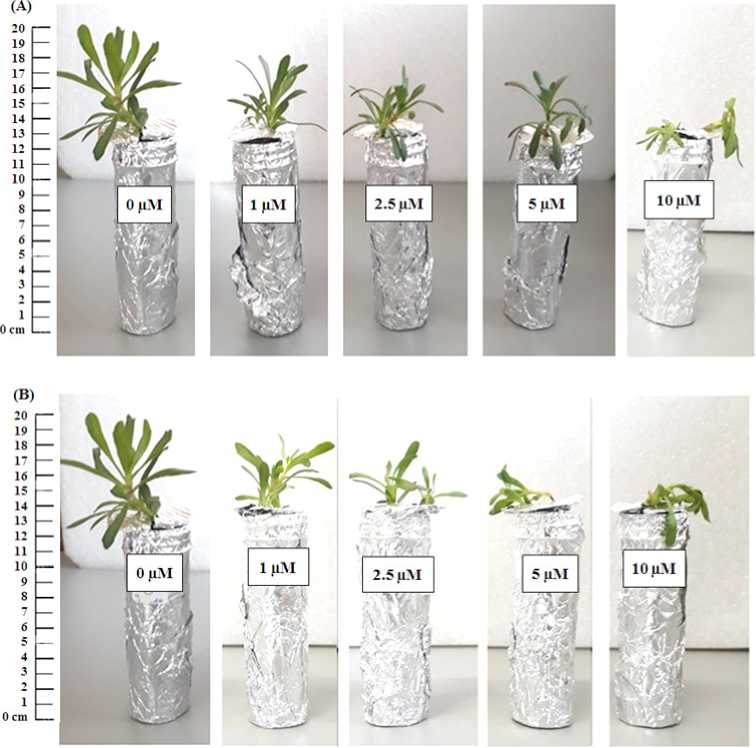
Figure 1. Limbarda crithmoides growth response to increased concentrations of La (A) and Ce (B) in hydroponic solutions after 14 days of exposure
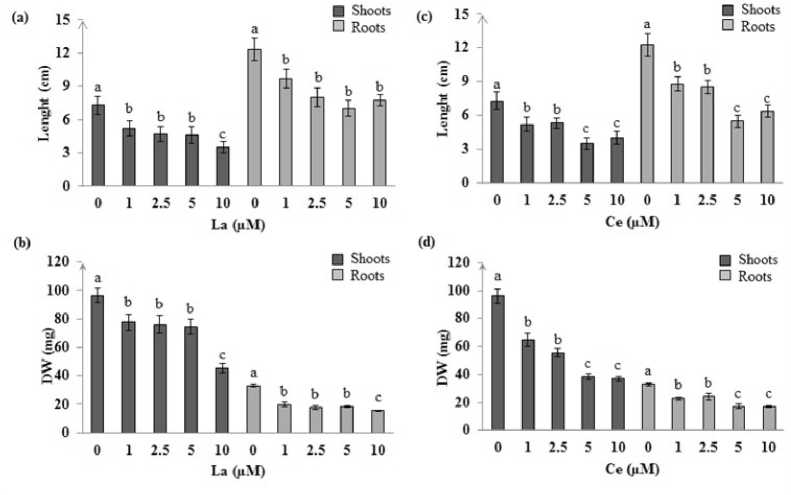
Figure 2. Length (a,c) and dry weight content (D –b,d) of the shoots and roots of Limbarda crithmoides plants after 14 days of La and Ce exposure. Data are mean values ± SD, n = 8. Bars marked with different lower-case letters were significantly different at p < 0.05
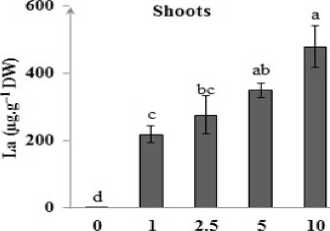
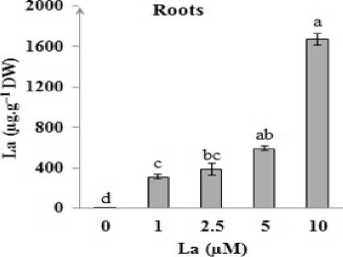
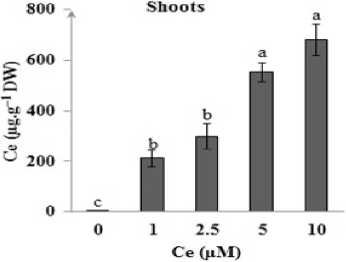
Figure 3. REEs (lanthanum –La, cerium –Ce) contents in shoots and roots of Limbarda crithmoides plants after 14 days of La and Ce exposure. Data are mean values ± SD, n = 8. Bars marked with different lower-case letters were significantly different at p < 0.05
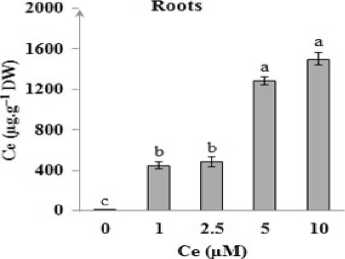
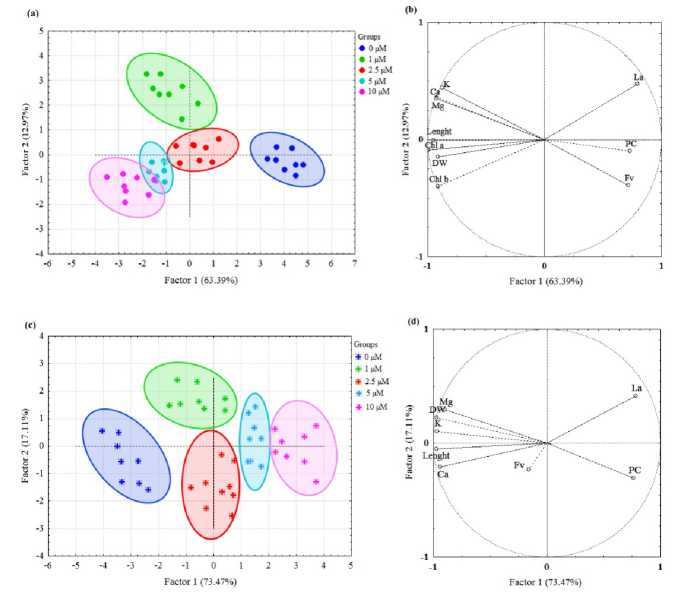
Figure 4. The principal component analysis (PCA) and the correlation circle from PCA of lanthanum concentration (La), plant organs length, dry biomass (D ), chlorophylls (Chl a and Chl b ), phenolic compounds (PC), flavonoids (Fv), potassium (K), calcium (Ca) and magnesium (Mg) data of the shoots (a,b) and roots (c,d) of Limbarda crithmoides

Figure 5. The principal component analysis (PCA) and the correlation circle from PCA of cerium concentration (Ce), plant organs length, dry biomass (D ), chlorophylls (Chl a and Chl b ), phenolic compounds (PC), flavonoids (Fv), potassium (K), calcium (Ca) and magnesium (Mg) data of the shoots (a,b) and roots (c,d) of Limbarda crithmoides
Table 1: Chlorophyll (Chl) a and b contents in Limbarda crithmoides leaves after 14 days of La and Ce exposure. Data are mean values ± SD, n = 8. Bars marked with different lower-case letters were significantly different at p < 0.05
|
La (µM) |
Chl a (mg.g–1 FW) |
Chl b (mg.g–1 FW) |
Chl a + Chl b |
Chl a / Chl b |
|
0 |
0.66 ± 0.01a |
0.36 ± 0.01a |
1.02 ± 0.02 |
1.86 ± 0.01 |
|
1 µM |
0.41 ± 0.01b |
0.28 ± 0.02b |
0.69 ± 0.01 |
1.50 ± 0.01 |
|
2.5 µM |
0.43 ± 0.01b |
0.27 ± 0.02b |
0.70 ± 0.02 |
1.57 ± 0.03 |
|
5 µM |
0.37 ± 0.00c |
0.19 ± 0.01c |
0.56 ± 0.01 |
1.94 ± 0.02 |
|
10 µM |
0.24 ± 0.01d |
0.15 ± 0.01c |
0.39 ± 0.02 |
1.66 ± 0.01 |
|
Ce (µM) |
Chl a (mg.g–1 FW) |
Chl b (mg.g–1 FW) |
Chl a + Chl b |
Chl a / Chl b |
|
0 |
0.66 ± 0.01a |
0.36 ± 0.01a |
1.02 ± 0.01 |
1.86 ± 0.02 |
|
1 µM |
0.47 ± 0.01b |
0.24 ± 0.01b |
0.71 ± 0.02 |
1.92 ± 0.01 |
|
2.5 µM |
0.45 ± 0.01b |
0.27 ± 0.02b |
0.72 ± 0.02 |
1.66 ± 0.02 |
|
5 µM |
0.26 ± 0.01c |
0.16 ± 0.01c |
0.42 ± 0.03 |
1.64 ± 0.01 |
|
10 µM |
0.20 ± 0.01d |
0.17 ± 0.01c |
0.37 ± 0.01 |
1.19 ± 0.02 |
Table 2: Macronutrients (potassium –K, calcium –Ca, magnesium –Mg), phenolic compounds (PC) and flavonoid (Fv) contents in shoots and roots of Limbarda crithmoides plants after 14 days of La and Ce exposure. Data are mean values ± SD, n = 8. Values with different lower-case letters were significantly different at p < 0.05
|
K (mg.g |
–1 DW) |
Ca (mg.g–1 DW) |
Mg (mg.g |
–1 DW) |
PC (mg.g–1 DW) |
Fv (mg.g–1 DW) |
||||
|
La (µM) |
Shoots |
Roots |
Shoots |
Roots |
Shoots |
Roots |
Shoots |
Roots |
Shoots |
Roots |
|
0 |
37.1 ± 1.0a |
26.3 ± 0.2a |
18.2 ± 0.3a |
11.6 ± 0.6a |
15.9 ± 0.3a |
6.1 ± 0.2a |
9.0 ± 0.4c |
10.7 ± 0.5d |
5.5 ± 0.5b |
4.0 ± 0.3a |
|
1 |
28.5 ± 1.1b |
22.1 ± 0.9b |
11.5 ± 0.8b |
9.8 ± 0.7ab |
12.1 ± 0.7b |
4.9 ± 0.3a |
26.3 ± 1.7a |
28.3 ± 0.3b |
16.5 ± 0.2a |
4.1 ± 0.4a |
|
2.5 |
31.7 ± 1.6b |
22.3 ± 1.4b |
11.7 ± 1.4b |
9.2 ± 0.6ab |
12.4 ± 1.1b |
4.1 ± 0.3a |
27.0 ± 1.0a |
22.2 ± 0.7c |
15.7 ± 0.2a |
4.3 ± 0.3a |
|
5 |
31.9 ± 0.9b |
21.1 ± 1.1b |
13.7 ± 1.6b |
8.7 ± 0.6b |
13.2 ± 0.5b |
4.4 ± 0.2a |
30.9 ± 1.7a |
20.0 ± 1.1c |
17.7 ± 0.3a |
3.0 ± 0.6a |
|
10 |
29.7 ± 0.7b |
21.3 ± 0.7b |
10.5 ± 1.5b |
8.6 ± 0.5b |
11.8 ± 0.7b |
4.6 ± 0.4a |
21.5 ± 1.4b |
32.3 ± 0.8a |
14.7 ± 0.1a |
3.8 ± 0.6a |
|
K (mg.g |
–1 DW) |
Ca (mg.g–1 DW) |
Mg (mg.g |
–1 DW) |
PC (mg.g–1 DW) |
Fv (mg.g–1 DW) |
||||
|
Ce (µM) |
Shoots |
Roots |
Shoots |
Roots |
Shoots |
Roots |
Shoots |
Roots |
Shoots |
Roots |
|
0 |
37.1 ± 1.0a |
26.3 ± 0.2a |
18.2 ± 0.3a |
11.6 ± 0.6a |
15.9 ± 0.3a |
6.1 ± 0.2a |
9.0 ± 0.4c |
10.7 ± 0.5c |
5.5 ± 0.5b |
4.0 ± 0.3a |
|
1 |
36.1 ± 0.7a |
24.2 ± 1.0ab |
10.2 ± 0.4b |
9.9 ± 0.3ab |
12.6 ± 0.7b |
4.9 ± 0.3a |
21.7 ± 0.7a |
30.5 ± 1.1a |
15.0 ± 0.2a |
3.1 ± 0.1a |
|
2.5 |
32.9 ± 0.5b |
21.2 ± 0.8b |
11.7 ± 0.3b |
9.6 ± 0.7ab |
12.8 ± 0.1b |
4.5 ± 0.5a |
21.0 ± 1.1a |
31.3 ± 1.5a |
13.5 ± 0.3a |
4.4 ± 0.4a |
|
5 |
29.4 ± 1.4b |
15.4 ± 0.3c |
10.2 ± 0.4b |
7.3 ± 0.6b |
12.4 ± 0.3b |
3.3 ± 0.5b |
22.4 ± 0.9a |
25.7 ± 1.3b |
16.2 ± 0.3a |
4.7 ± 0.4a |
|
10 |
30.9 ± 1.4b |
15.5 ± 0.8c |
11.9 ± 0.5b |
7.1 ± 0.7b |
12.0 ± 0.7b |
3.3 ± 0.3b |
17.8 ±0.5b |
29.4 ± 0.5a |
17.3 ± 0.4a |
3.6 ± 0.2a |
These findings are in agreement with Dridi et al. (2022b) study who reported the increase of phenolic compounds in Helianthus annuus treated with similar La and Ce concentrations (0-10 µM). Additionally, Limbarda crithmoides showed a significant increase of these compounds in its shoots and roots of plants grown in the presence of barium and lead (Dridi et al. , 2022c,d). Moreover, an increase in total phenols and flavonoid contents was observed in Withania Somnifera and Fagopyrum Esculentum plants under cadmium and aluminum stress, respectively (Smirnov et al. , 2015; Mishra et al. , 2019).
It has been reported that under metal stress, plants enhance the accumulation of phenolic compounds and flavonoids in plant cells through the up-regulation of the biosynthesis of phenylpropanoid enzymes including phenylalanine ammonia-lyase, polyphenol oxidase, chalcone synthase, shikimate dehydrogenase and cinnamyl alcohol dehydrogenase (Sharma et al. , 2019). Indeed, phenolic compounds and flavonoids participate in the metal chelation process to reduce the levels of harmful hydroxyl radical in plant cells and thus to protect the plants from oxidative damage (Mira et al. , 2002; illiams et al. , 2004).
However, high accumulated levels in some phenolic compounds such as trans-cinnamic acid, coumarin, p-hydroxybenzoic acid, and benzoic acid (Baleroni et al., 2000) or in flavonoids such as monohydroxy B-ring flavonoids and dihydroxy B-ring flavonoids (Mathesius et al., 2001) could be potentially phytotoxic and induce plant growth inhibition (Sharma et al., 2019). This effect can be due to the inhibition of indole-acetic acid synthesis (Mathesius et al., 2001), hampering of polar auxin transport (Patakas, 2012), impairment of plant cell division and disruption of cellular enzyme functioning (Sharma et al., 2019).
Principal component analysis
Principal component analysis (PCA) was performed to study the effect of La and Ce on the physiological and biochemical parameters and to evaluate the correlation between all these latter that were determined in L. crithmoides aerial– and under–ground parts (Figures 4 and 5). Statistical results showed that the multifactorial analysis of La or Ce impact indicated that axis were Factor 1 and Factor 2, where Factor 1 explained the variance of 63.39% and 73.47% in the shoots and roots of La treatment (Figure 4) and 66.27% and 51.61% in the same organs of Ce treatment (Figure 5), respectively, whilst Factor 2 showed only 12.79% and 17.11% of variance in shoots and roots of La treated plants (Figure 4), and 21.22% and 25.60% in shoots and roots of Ce treated plants (Figure 5), respectively. The two components explained a total variance of 76.18% and 90.58% in La treated plants and 87.49% and 77.21% in Ce treated plants in the shoots and roots, respectively, making these findings highly significant for the present study. The PCA revealed a clear separation between scores of the control and those of all La concentrations in both shoots and roots of the treated plants (Figure 4a,c). A clear separation was also noted between the lowest La concentration (1 µM) and the highest ones (2.5, 5 and 10 µM) in shoots (Figure 4a) and roots (Figure 4c), in addition, scores of 2.5 µM group was also separated of 5 and 10 µM groups in the roots (Figure 4c). Regarding Ce conditions, results showed a clear separation only between of the control and all Ce concentrations in both shoots and roots (Figure 5a,c). According to the PCA correlation circle (Figure 4b), shoots of L. crithmoides showed that La was negatively correlated to shoot length, D , Chl a, and Chl b, where a positive correlation between all of shoot length, D , Chl a, Chl b, K, Ca, Mg contents was observed under the effect of La treatment (Figure 4b). Roots of La treated plants showed also a negative correlation between La and root length, D , Ca, and K contents and a positive correlation between La and phenolic compounds (Figure 4d). All of root length, D , Ca, K and Mg were positively correlated under La stress (Figure 4d). Figure 7 revealed negative correlations between Ce and length, D , Chl a, Chl b, Mg and K in shoots (Figure 5b) and between Ce and length, D , K, Ca and Mg in roots (Figure 5d) whereas all of these parameters were found positively correlated under Ce exposure.
CONCLUSION
In the present study, Limbarda crithmoides was shown to be too sensitive to La and Ce stress. Both La and Ce could be highly accumulated in the roots and shoots of L. crithmoides resulting in an inhibition of the growth, a reduction in chlorophyll content and a nutrition imbalance (decreased K, Ca and Mg levels in shoots and roots). Despite the increase in the accumulated phenolic compounds and flavonoids, we can assume that the antioxidant system was not sufficient enough to protect the plant from the stress and that the defence was surpassed by the oxidative damage leading the plant to wilt specifically at the highest La and Ce doses. According to this study, it can be admitted that, since the treated plants were severely affected by the concentrations of 5 µM Ce and 10 µM La, these latter present lethal doses for L. crithmoides that can be used as bioindicator species in REEs polluted soils.
CONFLICTS OF INTEREST
The authors declare that they have no potential conflicts of interest.
Список литературы Assessment of lanthanum (La) and cerium (Ce) phytotoxicity in a halophyte species: Limbarda crithmoides L
- Aggarwal A., Sharma I., Tripathi B.N. (2012). Metal toxicity and photosynthesis. In: Photosynthesis: Overviews on Recent Progress and Future Perspectives, 229-236.
- Alonso E., Sherman A.M., Wallington T.J., Everson M.P., Field F.R., Roth R., (2012). Evaluating rare earth element availability: A case with revolutionary demand from clean technologies. Environ Sci Technol., 46(6):3406.
- Altman A. (2003). From plant tissue culture to biotechnology: scientific revolutions, abiotic stress tolerance, and forestry. In Vitro Cell Dev. Biol. Plant 39:75-84.
- Andreani S., De Cian M.C., Paolini J., Desjobert J.M., Costa J., Muselli A. (2013). Chemical Variability and Antioxidant Activity of Limbarda crithmoides L. Essential Oil from Corsica. Chem. Biodivers., 10:2061-2077.
- Baleroni C.R.S., Ferrarese M.L.L., Souza N.E., Ferrarese-Filho O. (2000). Lipid Accumulation during Canola Seed Germination in response to Cinnamic Acid Derivatives. Biol. Planta, 43:313316.
- Bankaji I., Cagador I., Sleimi N. (2016). Assessing of tolerance to metallic and saline stresses in the halophyte Suaeda fruticosa: The indicator role of antioxidative enzymes. Ecol. Indic., 64:297-308.
- Brito P., Ferreira R.A., Martins-Dias S., Azevedo O.M., Caetano M., Cagador I. (2021). Cerium uptake, translocation and toxicity in the salt marsh halophyte Halimione portulacoides (L.) Aellen. Chemosphere, 266, 128973.
- Burda K., Strzalka K., Schmid G.H. (1995). Europium-and dysprosium-ions as probes for the study of calcium binding sites in photosystem II. Zeitschrift für Naturforschung, 50:220-230.
- Chaves M.M., Flexas J., Pinheiro C. (2009). Photosynthesis under drought and salt stress: regulation mechanisms from whole plant to cell. Ann. Bot., 103:551-560.
- DalCorso G., Manara A., Furini A. (2013). An overview of heavy metal challenge in plants: from roots to shoots. Metallomics 5 (9): 1117-1132.
- Dridi N., Ferreira R., Bouslimi H., Brito P., Martins-Dias S., Caçador I., Sleimi N. (2022b). Assessment of Tolerance to Lanthanum and Cerium in Helianthus Annuus Plant: Effect on Growth, Mineral Nutrition, and Secondary Metabolism. Plants, 11, 988.
- Dridi N., Bouslimi H., Duarte B., Caçador I., Sleimi N. (2022c). Evaluation of Physiological and Biochemical Parameters and Some bioindicators of Barium Tolerance in Limbarda crithmoides and Helianthus annuus. Int. J. Plant Biol., 13:115-131.
- Dridi N., Bouslimi H., Caçador I., Sleimi N. (2022d). Lead tolerance, accumulation and translocation in two Asteraceae plants: Limbarda crithmoides and Helianthus annuus. South African Journal of Botany, 150:986-996.
- El Zrelli R., Rabaoui L., Ben Alaya M., Castet S., Zouiten C., Bejaoui N., Courjault-Radé P. (2019a). Decadal effects of solid industrial wastes on the coast: Gulf of Gabes (Tunisia, Southern Mediterranean Sea) as an example. Estuar. Coast. Shelf Sci., 224:281288.
- El Zrelli R., Rabaoui L., Van Beek P., Castet S., Souhaut M., Grégoire M., Courjault-Radé P., (2019c). Natural radioactivity and radiation hazard assessment of industrial wastes from the coastal phosphate treatment plants of Gabes (Tunisia, Southern Mediterranean Sea). Mar. Pollut. Bull., 146:454-461.
- El-Sherbeny G.A., Dakhil M.A., Eid E.M., Abdelaal M. (2021). Structural and Chemical Adaptations of Artemisia monosperma Delile and Limbarda crithmoides (L.) Dumort. In Response to Arid Coastal Environments along the Mediterranean Coast of Egypt. Plants, 10, 481.
- El-Zrelli R., Baliteau J. Y., Yacoubi L., Castet S., Grégoire M., Fabre S., Sarazin V., Daconceicao L., Courjault-Radé P., Rabaoui. L. (2021). Rare earth elements characterization associated to the phosphate fertilizer plants of Gabes (Tunisia, Central Mediterranean Sea): Geochemical properties and behavior, related economic losses, and potential hazards. Science of the Total Environment 791:148268.
- Gupta D., Nicoloso F., Schetinger M. (2009). Antioxidant defense mechanism in hydroponically grown Zea mays seedlings under moderate lead stress. J. Hazard. Mater., 172 (1): 479-484.
- Han F., Shan X.Q., Zhang J., Xie Y.N., Pei Z.G., Zhang S.Z. (2005). Organic acids promote the uptake of lanthanum by barley roots. New Phytol., 165:481.
- Henderson P. (1984). General geochemical properties and abundances of the rare earth dements. In Rare Earth Element Geochemistry, P. Henderson, ed., 510 pp.
- Hoagland D.R., Arnon D.I. (1950). The water-culture method for growing plants without soil. Circular. Calif. Agric. Exp. Stn., 347, 32.
- Hu X., Wang X.R., Wang C. (2006). Bioaccumulation of lanthanum and its effect on growth of maize seedlings in a red loamy soil. Pedosphere 16: 799805.
- Imlay J.A. (2003). Pathways of oxidative damage. Annu Rev Microbiol, 57:395-418.
- Jiang C., Gao X., Liao L., Harberd N.P., Fu X. (2007). Phosphate starvation root architecture and anthocyanin accumulation responses are modulated by the gibberellin-DELLA signalling pathway in Arabidopsis. Plant Physiol, 145:14601470.
- Jones A. (2000). Does the plant mitochondrion integrate cellular stress and regulate programmed cell death? Trends Plant Sci., 5:273-278.
- Klusener B., Boheim G., Liss H., Engelberth J., Weiler E.W. (1995). Gadolinium sensitive, voltage-dependent calcium-release channels in the endoplasmic reticulum of a higher-plant mechanoreceptor organ. Embo J., 14:2708-2714.
- Kosak née Rohdera L. A., Brandta T., Sigga L., Behra R. (2018). Uptake and effects of cerium (III) and cerium oxide nanoparticles to Chlamydomonas reinhardtii. Aquatic Toxicology, 197:41-46.
- Kotelnikova A., Fastovets I., Rogova O., Volkov D. S., Stolbova V. (2019). Toxicity assay of lanthanum and cerium in solutions and soil. Ecotox. Env. Saf., 167:20-28.
- Lamaison J.L., Carnat A. (1990). Teneurs en acide rosmarinique, en dérivés hydroxycinnamiques totaux et activités antioxydantes chez les Apiacées, les Borraginacées et les Lamiacées médicinales. Pharm. Acta Helv., 65:315-320.
- Leyser O. (2005). Auxin distribution and plant pattern formation: how many angels can dance on the point of PIN? Cell, 121:819-822.
- Li X.F., Chen Z., Chen Z.B., Chen Z.Q., Zhang Y.H. (2013). A human health risk assessment of rare earth elements in soil and vegetables from a mining area in Fujian Province, Southeast China. Chemosphere, 93(6):1240.
- Liu C., Liu W.S., Huot H., Yang Y.M., Guo M.N., Morel J. L., Tang Y.T., Qiu. R.L. (2022). Responses of ramie (Boehmeria nivea L.) to increasing rare earth element (REE) concentrations in a hydroponic system. Journal of rare earth, 40:840-846.
- Liu Y., Xu L., Dai Y. (2018). Phytotoxic Effects of Lanthanum Oxide Nanoparticles on Maize (Zea mays L.). IOP Conf. Series: Earth and Environmental Science, 113:012020.
- Macedo A. F. (2012). Abiotic Stress Responses in Plants: Metabolism to Productivity. Review in P. Ahmad and M.N.V. Prasad (eds.), Abiotic Stress Responses in Plants: Metabolism, Productivity and Sustainability. Springer: 41-61.
- Mali M., Aery N. C. (2009). Effect of silicon on growth, biochemical constituents and mineral nutrition of cowpea (Vigna unguiculata (L.) Walp.). Commun. Soil Sci. Plant Anal., 40:1041-1052.
- Mathesius U. (2001). Flavonoids induced in cells undergoing nodule organogenesis in white clover are regulators of auxin breakdown by peroxidase. J. Exp. Bot., 52:419-426.
- Mira L., Fernandez M.T., Santos M., Rocha R., Florencio M.H., Jennings K.R. (2002). Interactions of flavonoids with iron and copper ions: A mechanism for their antioxidant activity. Free Radic. Res., 36:1199-1208.
- Mishra B., Sangwan N.S. (2019). Amelioration of cadmium stress in Withania somnifera by ROS management: Active participation of primary and secondary metabolism. Plant Growth Regul., 87:403-412.
- Mumm P., Wolf T., Fromm J. (2011). Cell type-specific regulation of ion channels within the maize stomatal complex. Plant Cell Physiol., 52: 1365-1375.
- Nada E., Ferjani B.A., Ali R., Bechir B.R., Imed M., Makki B. (2007). Cadmium-induced growth inhibition and alteration of biochemical parameters in almond seedlings grown in solution culture. Acta Physiol Plant, 29:57-62.
- Paponov I.A., Teale W.D., Trebar M., Blilou I., Palme K. (2005). The PIN auxin efflux facilitators: evolutionary and functional perspectives. Trends Plant Sci., 10: 170-177.
- Parmar T. K., Rawtani D., Agrawal Y.K. (2016). Bioindicators: the natural indicator of environmental pollution. Frontiers in life science, 9: 110-118.
- Patakas A. (2012). Abiotic Stress-Induced Morphological and Anatomical Changes in Plants. In P. Ahmad and M.N.V. Prasad (eds.), Abiotic Stress Responses in Plants: Metabolism, Productivity and Sustainability. Springer, 21-39.
- Qiu G., Li W., Li X., Zhou W., Yang C. (2005). Biological intelligence of rare earth elements in animal cells. J. Rare Earth., 23: 554-573.
- Reichheld J.P., Vernoux T., Lardon F., Van-Montagu M., Inze D. (1999). Specific checkpoints regulate plant cell cycle progression in response to oxidative stress. Plant J., 17: 647-656.
- Rezaee A., Hale B., Santos R.M., Chiang Y.W. (2017). Accumulation and Toxicity of Lanthanum and Neodymium in Horticultural Plants (Brassica chinensis L. and Helianthus annuus L.). Can. J. Chem. Eng., 96:2263-2272.
- Ros-Barcelo A., Pomar F., Lopez-Serrano M., Martinez P., Pedreno M.A. (2002). Developmental regulation of the H2O2-producing system and of a basic peroxidase isoenzyme in the Zinnia elegans lignifying xylem. Plant Physiol Biochem., 40:325332.
- Schrader J., Baba K., May S.T., Palme K., Bennett M., Bhalerao R.P., Sandberg G. (2003). Polar auxin transport in the wood-forming tissues of hybrid aspen is under simultaneous control of developmental and environmental signals. Proc. Natl. Acad. Sci. USA, 100:10096-10101.
- Schwenke H., Wagner E. (1992). A new concept of root exudation. Plant Cell Environ. 15:289-299.
- Sharma A., Shahzad B., Rehman A., Bhardwaj R., Landi M., Zheng B. (2019). Response of Phenylpropanoid Pathway and the Role of Polyphenols in Plants under Abiotic Stress. Molecules, 24, 2452.
- Sharma P., Dubey R.S. (2005). Lead toxicity in plants. Braz. J. Plant Physiol., 17:35-52.
- Sleimi N., Bankaji I., Kouki R., Dridi N., Duarte B., Caçador I. (2022). Assessment of extraction methods of trace metallic elements in plants: Approval of a common method. Sustainability, 14, 1428.
- Smirnov O.E., Kosyan A.M., Kosyk O.I., Taran N.Y. (2015). Response of phenolic metabolism induced by aluminium toxicity in Fagopyrum esculentum moench. plants. Ukr. Biochem. J., 87:129-135.
- Stolt J.P., Sneller F.E.C., Brynelsson T., Lundborg T., Schat H. (2003). Phytochelatin and cadmium accumulation in wheat. Environ. Exp. Bot., 49, 2128.
- Tammeba P., Wennberg T., Vuorela H., Vuorela P. (2004). HPLC microfraction coupled to a cellbased assay for automated online primary screening of calcium antagonistic components in plant extracts. Anal. Bioanal. Chem., 380: 614-618.
- Tian Z.H., Guo S.F., Li S.Q., Sun Q.X., Cao L. (2016). Effects of La on Several Physiological and Biochemical Indexes and Chloroplast Ultrastructure of Honeysuckle. J. Chin. Rare Earths, 34:469-476.
- Velioglu Y.S., Mazza G., Gao L., Oomah B.D. (1998). Antioxidant Activity and Total Phenolics in Selected Fruits, Vegetables, and Grain Products. J. Agric. Food Chem., 46, 4113-4117.
- Wang X., Shi G. X., Xu Q. S., Xu B. J, Zhao J. (2007). Lanthanum and cerium induced oxidative stress in submerged Hydrilla verticillata plants. Russ. J. Plant Physiol., 54, 693-697.
- Wany C., Shi C., Liu L., Wang C. Qiao W., Gu Z., Wang X. (2012). Lanthanum element induced imbalance of mineral nutrients, hsp 70 production and DNAprotein crosslink, leading to hormetic response of cell cycle progression in root tips of Vicia Faba L. seedlings. Dose-Response: An International Journal, 10:96-107.
- Williams R.J., Spencer J.P., Rice-Evans C. (2004). Flavonoids: Antioxidants or signaling molecules? Free. Radic. Biol. Med., 36, 838-849.
- Winkel-Shirley B. (2002). Biosynthesis of fl avonoids and effects of stress. Curr Opin Plant Biol, 5:218-223.
- Yin H., Wang J., Zeng Y., Shen X., He Y., Ling L., Cao L., Fu X., Peng L., Chun C. (2021). Effect of the Rare Earth Element Lanthanum (La) on the Growth and Development of Citrus Rootstock Seedlings. Plants, 10, 1388.
- Yuan M., Guo M.N., Liu W.S., Liu C., van der Ent A., Morel J.L. (2017). The accumulation and fractionation of rare earth elements in hydroponically grown Phytolacca americana, L. Plant Soil., 421:66.
- Zeng Q., Zhu J.G., Cheng H.L., Xie Z.B., Chu H.Y. (2006). Phytotoxicity of lanthanum in rice in haplic acrisols and cambisols. Ecotoxicology and Environmental Safety, 64:226-233.
- Zhang W., Ebbs S. D., Musante C., White J. C., Gao C., Ma X. (2015). Uptake and Accumulation of Bulk and Nanosized Cerium Oxide Particles and Ionic Cerium by Radish (Raphanus sativus L.). J. Agric. Food Chem., 63:382-390.
- Zurayk R.A., Baalbaki R. (1996). Inula crithmoides: A Candidate Plant for Saline Agriculture. Arid Soil Res. Rehabil., 10, 213-223.

